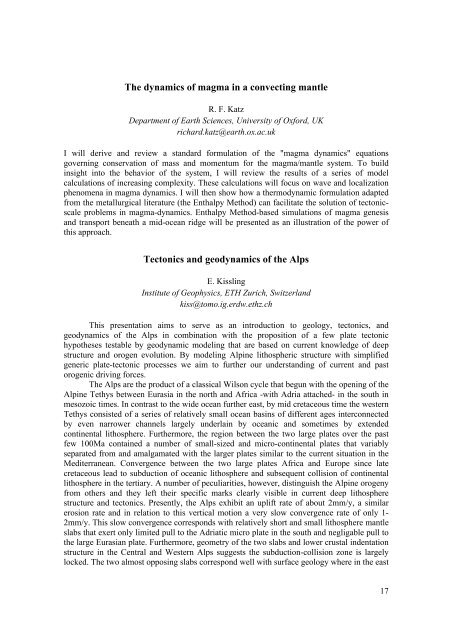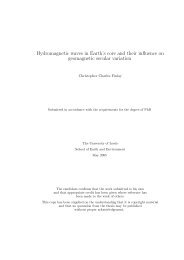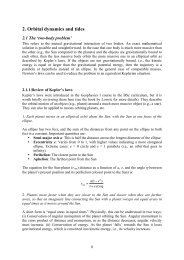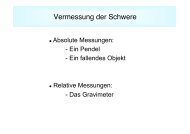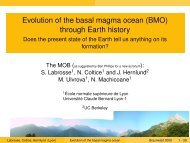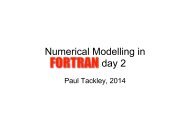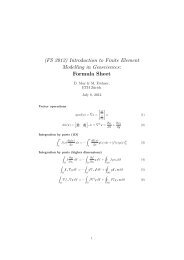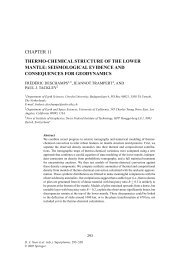infrequent updates of the localization conditions is sufficient, thus in practice the iMSFVmethod is not significantly more expensive than the original MSFV method. A further topic ismulti-scale modeling of transport, which becomes more relevant as the cost for the flowcomputations is significantly reduced. A successful strategy consists in adaptively switchingbetween coarse and fine transport equations depending on the local saturation/concetrationvariation. However, efficient and accurate treatment of transport in heterogeneous porousmedia remains a challenging research topic with many open questions. Finally, thepresentation will cover the potential of such multi-scale methods for multi-physicsapplications, e.g. for coupled systems, w<strong>here</strong> different sub-domains are governed either by theNavier-Stokes equations or Darcy's law [2].References[1] T. Arbogast. Implementation of a locally conservative numerical subgrid upscalingscheme for two-phase Darcy flow. Journal of Computational Geosciences, 6:453--481,2002[2] G. Bonfigli and P. Jenny. An efficient multi-scale Poisson solver for the incompressibleNavier-Stokes equations with immersed boundaries. Submitted to Journal ofComputational Physics, 2008[3] L. J. Durlofsky. Numerical calculation of equivalent grid block permeability tensors forheterogeneous porous media. Water Resour. Res., 27: 699--708, 1991[4] H. Hajibeygi, G. Bonfigli, M. A. Hesse and P. Jenny. Iterative multiscale finite-volumemethod. Journal of Computational Physics, 19:8604--8621, 2008[5] T. Y. Hou and X. H. Wu. A multiscale finite element method for elliptic problems incomposite materials and porous media. Journal of Computational Physics, 134(1):169--189, 1997[6] P. Jenny, S. H. Lee and H. Tchelepi. Multi-scale finite-volume method for ellipticproblems in subsurface flow simulation. Journal of Computational Physics, 187(1), pp.47-67, 2003[7] P. Jenny and I. Lunati. Modeling Complex Wells with the Multi-Scale Finite-VolumeMethod. Journal of Computational Physics, 2008[8] I. Lunati and P. Jenny. Multiscale Finite-Volume Method for Compressible MultiphaseFlow in Porous Media. Journal of Computational Physics, 216, pp. 616-636, 2006[9] I. Lunati and P. Jenny. Multi-Scale Finite-Volume Method for Density-Driven Flow inPorous Media. Journal of Computational Geosciences, 2008[10] J.M. Nordbotten and P.E. Bjrstad. On the relationship between the multiscale finitevolumemethod and domain decomposition preconditioners. Journal of ComputationalGeosciences, 12(3):367--376, 2008[11] C. Wolfsteiner, S. H. Lee, and H. A. Tchelepi. Well modeling in the multiscale finitevolume method for subsurface flow simulation. Multiscale Model. Simul., 200616
The dynamics of magma in a convecting mantleR. F. KatzDepartment of Earth Sciences, University of Oxford, UKrichard.katz@earth.ox.ac.ukI will derive and review a standard formulation of the "magma dynamics" equationsgoverning conservation of mass and momentum for the magma/mantle system. To buildinsight into the behavior of the system, I will review the results of a series of modelcalculations of increasing complexity. These calculations will focus on wave and localizationphenomena in magma dynamics. I will then show how a thermodynamic formulation adaptedfrom the metallurgical literature (the Enthalpy Method) can facilitate the solution of tectonicscaleproblems in magma-dynamics. Enthalpy Method-based simulations of magma genesisand transport beneath a mid-ocean ridge will be presented as an illustration of the power ofthis approach.Tectonics and geodynamics of the AlpsE. KisslingInstitute of Geophysics, <strong>ETH</strong> Zurich, Switzerlandkiss@tomo.ig.erdw.ethz.chThis presentation aims to serve as an introduction to geology, tectonics, andgeodynamics of the Alps in combination with the proposition of a few plate tectonichypotheses testable by geodynamic modeling that are based on current knowledge of deepstructure and orogen evolution. By modeling Alpine lithospheric structure with simplifiedgeneric plate-tectonic processes we aim to further our understanding of current and pastorogenic driving forces.The Alps are the product of a classical Wilson cycle that begun with the opening of theAlpine Tethys between Eurasia in the north and Africa -with Adria attached- in the south inmesozoic times. In contrast to the wide ocean further east, by mid cretaceous time the westernTethys consisted of a series of relatively small ocean basins of different ages interconnectedby even narrower channels largely underlain by oceanic and sometimes by extendedcontinental lithosp<strong>here</strong>. Furthermore, the region between the two large plates over the pastfew 100Ma contained a number of small-sized and micro-continental plates that variablyseparated from and amalgamated with the larger plates similar to the current situation in theMediterranean. Convergence between the two large plates Africa and Europe since latecretaceous lead to subduction of oceanic lithosp<strong>here</strong> and subsequent collision of continentallithosp<strong>here</strong> in the tertiary. A number of peculiarities, however, distinguish the Alpine orogenyfrom others and they left their specific marks clearly visible in current deep lithosp<strong>here</strong>structure and tectonics. Presently, the Alps exhibit an uplift rate of about 2mm/y, a similarerosion rate and in relation to this vertical motion a very slow convergence rate of only 1-2mm/y. This slow convergence corresponds with relatively short and small lithosp<strong>here</strong> mantleslabs that exert only limited pull to the Adriatic micro plate in the south and negligable pull tothe large Eurasian plate. Furthermore, geometry of the two slabs and lower crustal indentationstructure in the Central and Western Alps suggests the subduction-collision zone is largelylocked. The two almost opposing slabs correspond well with surface geology w<strong>here</strong> in the east17
- Page 4 and 5: !!!!!!!!!!!!!!!!!!!!!!!!!!!!!!!!;00
- Page 7 and 8: *@/(%/:(#5*A*2$'5*=(),!/'//*+&!>!9'
- Page 9 and 10: What drives plates? What drives pla
- Page 11 and 12: @+/#'(!M'//*+&!K!>!1)&#,'!2:&);*7/!
- Page 13 and 14: !!!!!!!DE:-"#F-:***G/5%9-/*+H/#I/":
- Page 15 and 16: interact. Therefore, we still face
- Page 17 and 18: Development of efficient numerical
- Page 19: Multi-scale methods for flow and tr
- Page 23 and 24: Evolution of the basal magma ocean
- Page 25 and 26: separation of metal and silicates i
- Page 27: I’ll show our recent model of loc
- Page 30 and 31: Coseismic subduction zone strain-re
- Page 32 and 33: plumes persist throughout the model
- Page 34 and 35: ReferencesT. V. Gerya, et al. (2000
- Page 36 and 37: depth) and proposed a group of best
- Page 38 and 39: [7] J. Haruyama and 19 co-authors (
- Page 40 and 41: 1991) and the presence of non-arc r
- Page 42 and 43: Discussion on resolving sediment su
- Page 44 and 45: must be simulated at the correct vi
- Page 46 and 47: 0.3) buoyancy ratios induce stable
- Page 48 and 49: set up is similar to the experiment
- Page 50 and 51: e transported down and stored in th
- Page 52 and 53: Subduction stress accumulation and
- Page 54 and 55: axisymmetric octahedral cubicmode (
- Page 56 and 57: advection, cross-sectional area, nu
- Page 58 and 59: Continental deformation along the C
- Page 60 and 61: schemes: upwind differences, higher
- Page 62 and 63: Reconstructing the past thermal evo
- Page 64 and 65: this study, we examine parameter se
- Page 66 and 67: within it, in the cold lithospheric
- Page 68 and 69: investigate in more detail the conc
- Page 70 and 71:
Alaska that include the overriding
- Page 72 and 73:
ehavior in the direction of trench
- Page 74 and 75:
Modelling mantle dynamics and crust
- Page 76 and 77:
Upper mantle convective instability
- Page 78 and 79:
Investigating the physical properti
- Page 80 and 81:
influence of a NW push by the Adria
- Page 82 and 83:
parameters. The thermomechanical mo
- Page 84 and 85:
Core mantle boundary topography as
- Page 86 and 87:
considering the bending northern pa
- Page 88 and 89:
migration rates similar to the half
- Page 90 and 91:
Length-scale of compressible mantle
- Page 92 and 93:
The effects of glacial loading on l
- Page 94 and 95:
[4] A. Mohsen, R. Hofstetter, G. Bo
- Page 96 and 97:
either with imposed plate motions (
- Page 98 and 99:
is coupled to the mechanical one in
- Page 100 and 101:
ecognized with some confidence in t
- Page 102 and 103:
A benchmark study of mantle convect
- Page 104 and 105:
Figure: Correlation of predicted dy
- Page 106 and 107:
Figure 1. Planetary models using St
- Page 108 and 109:
Geodynamic modeling of terrane accr
- Page 110 and 111:
Longitude: Linking Earths ancient s
- Page 112 and 113:
Transitions in tectonic mode based
- Page 114 and 115:
Delamination takes place only in a
- Page 116 and 117:
jump on the pattern of flow are exp
- Page 118 and 119:
Alpert, Lisa Ann (laalpert@usc.edu)
- Page 120 and 121:
Hieronymus, Chris, Dr. (christoph.h
- Page 122 and 123:
Schmalholz, Stefan Markus, PD Dr. (


